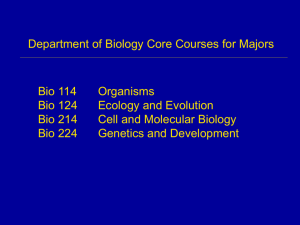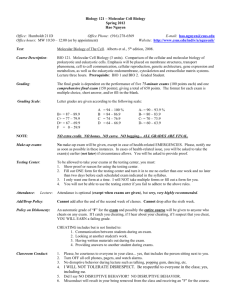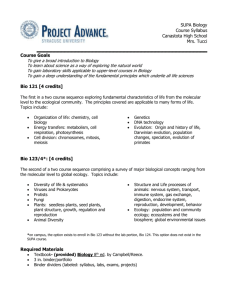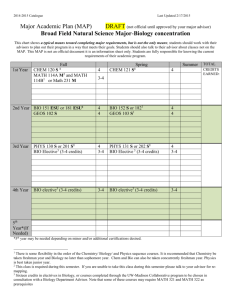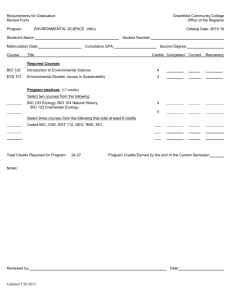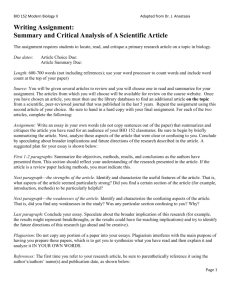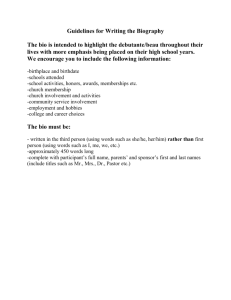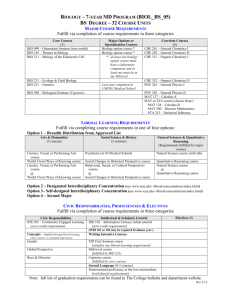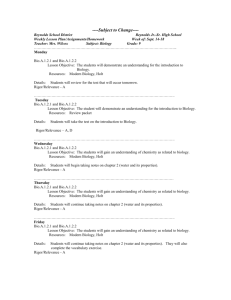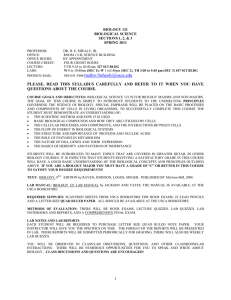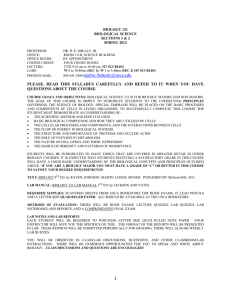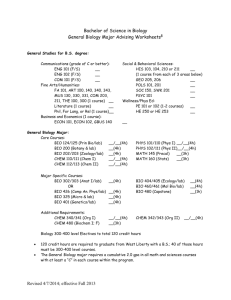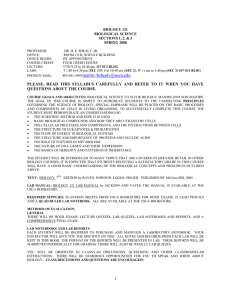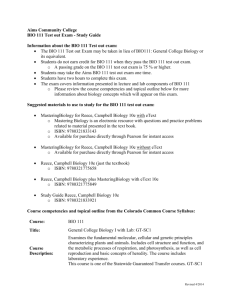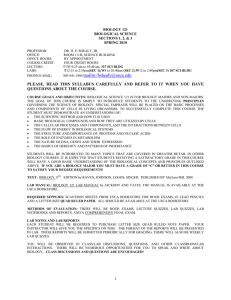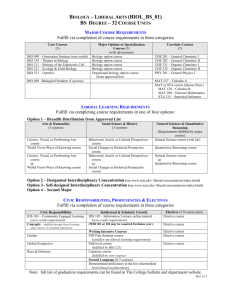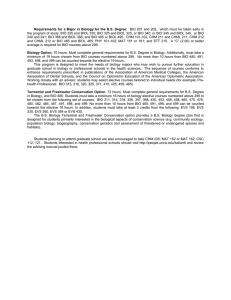BIO 1300G, Animal Diversity. - Eastern Illinois University
advertisement
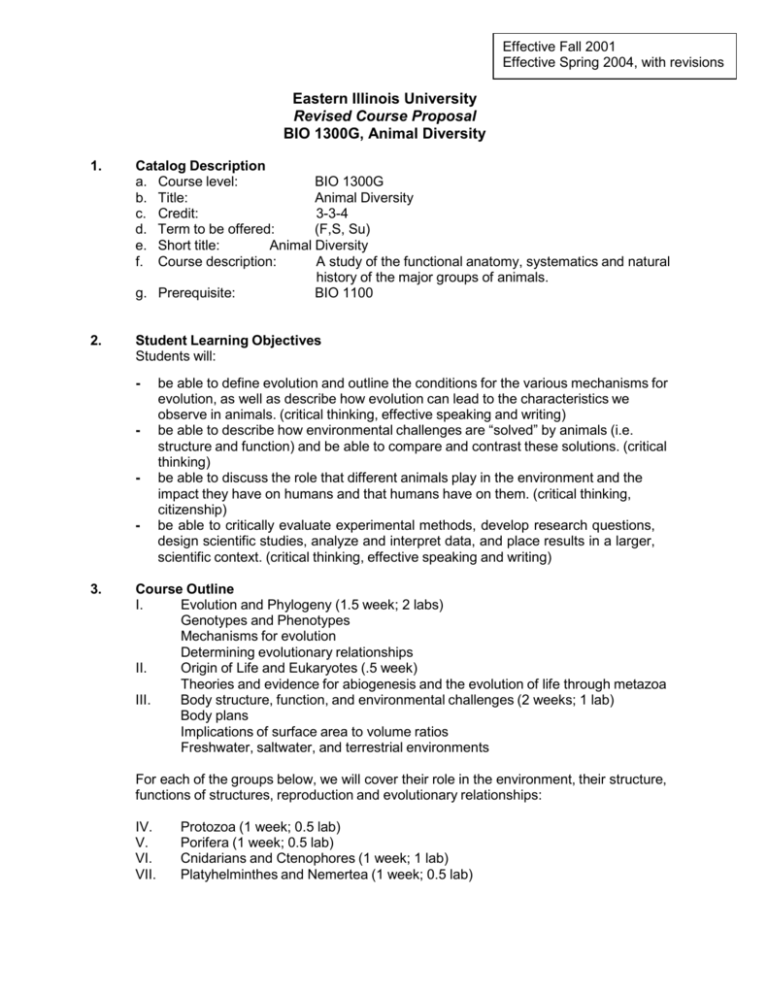
Effective Fall 2001 Effective Spring 2004, with revisions Eastern Illinois University Revised Course Proposal BIO 1300G, Animal Diversity 1. Catalog Description a. Course level: BIO 1300G b. Title: Animal Diversity c. Credit: 3-3-4 d. Term to be offered: (F,S, Su) e. Short title: Animal Diversity f. Course description: A study of the functional anatomy, systematics and natural history of the major groups of animals. g. Prerequisite: BIO 1100 2. Student Learning Objectives Students will: - - 3. be able to define evolution and outline the conditions for the various mechanisms for evolution, as well as describe how evolution can lead to the characteristics we observe in animals. (critical thinking, effective speaking and writing) be able to describe how environmental challenges are “solved” by animals (i.e. structure and function) and be able to compare and contrast these solutions. (critical thinking) be able to discuss the role that different animals play in the environment and the impact they have on humans and that humans have on them. (critical thinking, citizenship) be able to critically evaluate experimental methods, develop research questions, design scientific studies, analyze and interpret data, and place results in a larger, scientific context. (critical thinking, effective speaking and writing) Course Outline I. Evolution and Phylogeny (1.5 week; 2 labs) Genotypes and Phenotypes Mechanisms for evolution Determining evolutionary relationships II. Origin of Life and Eukaryotes (.5 week) Theories and evidence for abiogenesis and the evolution of life through metazoa III. Body structure, function, and environmental challenges (2 weeks; 1 lab) Body plans Implications of surface area to volume ratios Freshwater, saltwater, and terrestrial environments For each of the groups below, we will cover their role in the environment, their structure, functions of structures, reproduction and evolutionary relationships: IV. V. VI. VII. Protozoa (1 week; 0.5 lab) Porifera (1 week; 0.5 lab) Cnidarians and Ctenophores (1 week; 1 lab) Platyhelminthes and Nemertea (1 week; 0.5 lab) VIII. IX. X. XI. XII. XIII. XIV. 4. Pseudocoelomates (1 week; 0.5 lab) Mollusca (1 week; 1 lab) Annelida (1 week; 1 lab) Arthropoda (1 week; 1 lab) Other Protostome Phyla (1 week) Echinodermata (1 week; 1 lab) Chordata (1 week; 1 lab) Evaluation of Student Learning a. Grading Procedure (can vary with instructor): Lecture Evaluation: homework, quizzes, exams, cumulative final Laboratory Evaluation: homework, in-lab assignments, experiment write-ups, laboratory practical quizzes and exams, animal identifications, semester-long group research projects. b. Exams consist of multiple choice, short answer, and essay questions. Laboratory assignments are written responses to factual and conceptual questions; experiment write-ups are written, critical interpretation of experiments and results. Semester-long project is an original research project on a specific animal; students hand in written portions of the project periodically through the semester for feedback. The project culminates in a full scientific paper which includes references to primary literature. 5. Rationale a. Animal diversity belongs in the biological sciences component of the scientific awareness segment of the General Education Curriculum. As noted in the outline, students will become exposed to a wide variety of facts and concepts related to biology in general and animal biology in particular. Conceptual links are a critical part of this course; students are required to compare and contrast solutions to general challenges posed by the environment. The process of science is also stressed; students need to critically think about experimental questions, methods, results and interpretations. b. Animal Diversity is an introductory biology course, so is appropriate at the 1000 level. Students are exposed to many general biological concepts for the first time. BIO 1100 (General Biology) is a necessary prerequisite so that students have the necessary background in general biological principles to understand the concepts they will be exposed to in this course. c. This is a revision of BIO 1300C and should maintain the same curriculum ID as BIO 1300C. d. BIO 1300G is required by all majors and minors in the Biological Sciences. 6. Implementation a. Faculty members to whom the course will be assigned initially: Any qualified Biological Sciences faculty b. Text: Hickman, et al. (1997) Integrated Principles of Zoology, 10th edition (WC Brown, publisher) c. Course fee: $10.00 lab fee (previously approved by the President’s Council) d. Term to first be offered: Spring 2001 7. Community College Transfer A community college course may be judged equivalent to this course. 8. Date approved by the department: March 24, 2000 9. Date approved by the college curriculum committee: April 14, 2000 10. Date approved by CAA: October 19, 2000 Department Contact Person: Dr. Paul Switzer Campus phone: 217-581-6951

